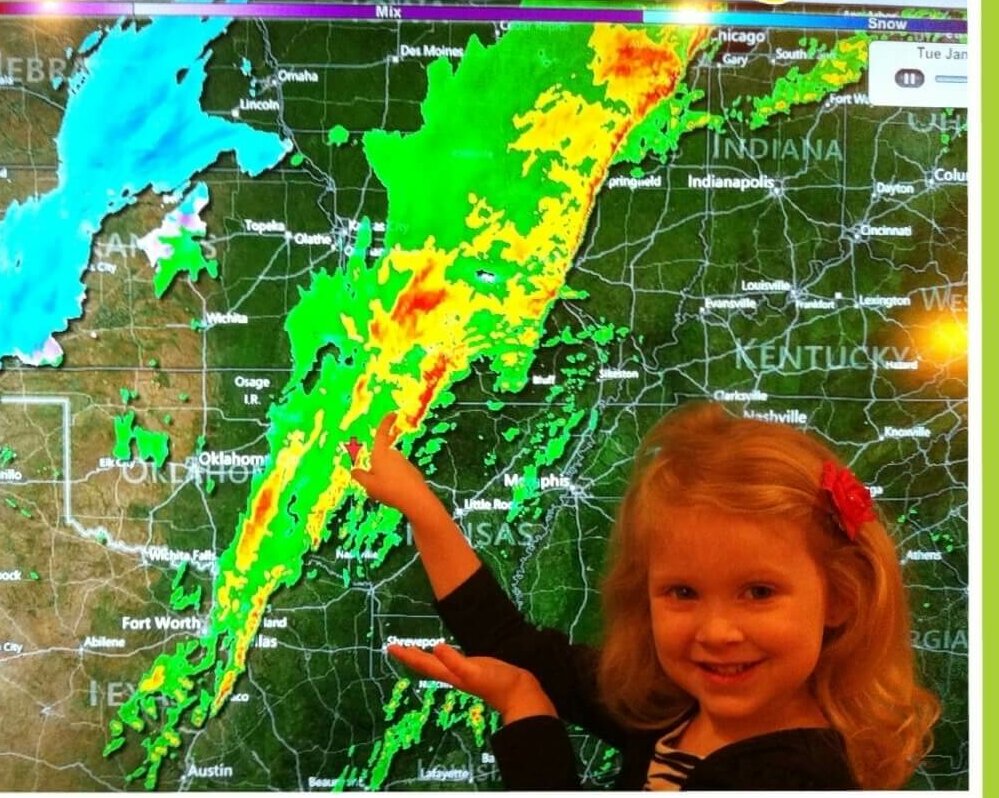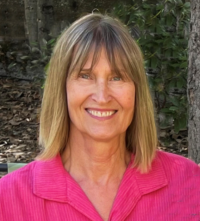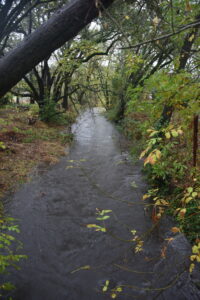Each week on her KSVY radio show, host Cat Smith grills a local expert with questions submitted by Sonoma Valley kids. This time, Patrick Zahn and Jeff Beamish, of Sonoma Technology, face the young panel.
Maya, age 10, asks could it ever snow in Sonoma? And Owen, age 10, wants to know, why do we not have snow at all?
ST: Great question. I think we can lump them all together here. Could it ever snow in Sonoma, and why do we not have snow at all? Well, there’s a nonzero chance every year that it could snow in Sonoma, right? But generally, it is just frankly too warm for it to snow here in Sonoma County. The reason being we have these storm systems in the winter that drop out of Canada or the Gulf of Alaska, very cold air masses. And oftentimes these storm systems have to pass over the Pacific Ocean. And what the Pacific Ocean does is modify or warm up that airmass just enough where it is too warm for snow to reach the ground here in the lower elevations of Sonoma County.
That being said it could still be cold in the upper levels of the atmosphere to the point that we could see a little bit of snow on say Sonoma Mountain or some of the other coastal ranges here in Northern California.
Ryane, age 11, asks what is smoke made of?
ST: It is a complex mixture, but mostly the smoke is made up of the things that have just burned. So especially if we have a wildfire in a forest area, we’re talking about trees mostly. And most of that is carbon. So we get these, what they call black carbon particles within the smoke. A lot of times when you see ash sort of raining down under a smoke plume, a lot of that is carbon. But in addition to that it can be a complex mixture of a lot of different types of particles, different types of molecules and different gases as well.
Age 10: Why does the sky turn red when there are fires?
ST: Ah, that’s the $64,000 question. You know, because that happened here in the Bay Area, this has to do with the scattering of sunlight. And I’m going to break this down into a couple of different discussions here.
Let’s start on a perfectly sunny day, perhaps like the one that we’re having here this afternoon. On a sunny day, the gases and the particles here in the atmosphere, they end up scattering more blue lights, than the other colors. That’s why it’s visible to us here on a clear sunny blue day that blue light is visible. On top of that, the reason that the blue light shows up better is that the sun has to travel a relatively short distance through the atmosphere to reach the ground.
Now, during a fire when there is smoke, the smoke, what it does is scatters the red and the orange colors way more effectively, and it blocks out that blue light. And that’s why during a fire when there is smoke around the sky can turn red. And it also has to do with the size of the particles. So the smoke particles are larger than the particles that the sunlight is normally scattered through so these larger particles tend to scatter the red colors.
Jonah, age 10, asks why is the earth slowly getting hotter? Also, what was the hottest day on earth recorded?
ST: Scientists have been taking measurements of the Earth’s temperature all over the globe for a long time now. And the evidence does indicate that yes, the Earth is slowly getting warmer. And I think we will have a chance to talk about this more a little bit later. But that’s largely because of the greenhouse effect, which warms the atmosphere. And there are some gases in the atmosphere that warm more than other gases. And humans have been adding those gases to the atmosphere for at least the last 150 years, leading to more warming than we would normally expect. It happens so gradually that you don’t necessarily notice it year to year. The warming effect has been really gradual over the last 100 years or so.
The second half of the question… while there is still a little bit up for debate, even though it happened back in 1913, yes, people are still debating this temperature and whether it is legitimate, but by all accounts it is still a legitimate reading and the hottest day recorded on Earth was in Death Valley, California back on July 10 of 1913 when the thermometer hit a blistering 134 degrees Fahrenheit.
Miles age 10 says, how did we figure out how to tell the weather?
ST: There are several things that help us figure out exactly what the weather is going to do and what may happen in the next seven to 10 days. First and foremost, the most important thing is what we just talked about, observational data. What’s the temperature right now? What’s the wind right now? We have weather stations, numerous weather stations across the country and across the world that tell us that. For our purposes here at Sonoma technology, we’re interested in that, but we’re interested also in the air quality monitors that are set up across the country. And I believe there’s probably over 2000 air quality monitors in over 48 states, and these measure things like ozone and particulate matter, dust, and smoke. Taking a look at those monitors and seeing what’s happening right now is certainly part of the puzzle. What’s happening right now. And then the other part of it is what’s happening in the future as well.
We have very sophisticated tools called weather models. And I think the shorthand answer to what a weather model is, it’s a big long math equation that takes in all sorts of different weather variables via moisture or wind or temperature, puts it all into an equation, and spits out a forecast for seven to 10 days out. So that’s the shorthand version of weather models.
Isabella, age 10 wants to know how does it (weather) knows to get ready for winter or spring, etc.?
ST: That’s a great question. I think generally the weather is just responding to the way that the earth is tilted. In relation to the sun in our orbit around the sun on a yearly basis, let’s think about during the wintertime, the Earth is actually tilted away from the sun, so we’re not seeing as much sunlight. So that’s why our days are cooler. Conversely, in the summertime, the Earth is tilted toward the sun, we see more sunlight, we see warmer days. So really, the weather is just responding to the way that the earth is tilted in relation to the sun.
Several kids asked this question. Why does the weather change so fast in one day? And how come it’s 80 degrees and then the next thing you know, it’s 100 degrees?
ST: Because we’re in Northern California, this is a great question. And Jeff and I have to deal with this a lot in our forecasts. Things can change really rapidly. And the air quality can change really rapidly. There are a number of factors that can influence the temperature, for instance, in a particular region. Some of it has to do with high-pressure systems, low-pressure systems, the wind direction, the wind speed, and one major driver of the temperature is the cloud cover. You might have cloud cover one day, and then it burns off the next day. But really, the rapidly changing weather from day to day is driven by different, what we call, “air masses.”
So you might have a cool air mass right next to a really warm one. And as you transition from one to the other, you can have a really rapid change in the temperature. And that’s often associated, for instance, with a cold front. A cold front is just a boundary between those two different air masses, one that’s warm, and one that’s much cooler. It can also work the other way where you have really quick heating from one day to the next.
In relation here in Northern California, that marine layer can certainly play tricks on our temperature, you can wake up to the 50s and low 60s, you can have that coastal marine layer into the Petaluma Valley and over Sonoma Mountain and into the valley floors into Napa County as well. But as the sun comes up, as it heats up the ground, we see that erosion of the marine layer, the winds start to shift around as well. And before you know, we go from 80 to 95. In the Bay Area specifically, the marine layer plays a huge influence. Also, how long are the winds coming off of the ocean. These are all things that can play a factor into how rapidly or how the temperature can just stay flat or stable for several hours during the day. And I look at this as a nice thing, because think about the places where it’s just hot all the time. You don’t get a break at night. So we’re kind of lucky that we get to cool off and then heat back up.
Jared, age 10. Why is there pollution?
ST: While there are numerous sources here on Earth, that generate air pollution among them, us, humans, by driving, by using plastics, by burning things, we contribute to air pollution. Wildfires contribute to air pollution. Factories contribute to air pollution. These are all different things that can take our clean air and dirty it up in a short amount of time
And Nathan, age 11 asks when is air pollution gonna stop?
ST: The short story is that air pollution is not going to stop, especially as long as humans are here. And we are emitting pollutants into the atmosphere. There are a lot of actions that we can take to minimize the amount of pollution that we’re emitting into the atmosphere. Some of those things we can do using cleaner energy. So instead of, say, burning coal for energy, using solar or wind energy. Reducing car trips, for instance, since there are millions of cars on the road. Taken together, they can add a lot of pollution to the atmosphere and if we all take some steps to reduce our car trips that can have a significant impact on the air quality.
Lucia age 10. wants to know, what is the ozone and Tyge, also age 10, wants to know, how big is the ozone layer?
So ozone? That’s a great question. And ozone can be complicated, but basically, an ozone molecule is three oxygen atoms tied together. And the thing that we learn as air quality scientists and forecasters is that ozone near the ground is harmful. Ozone high up above the ground, actually is helpful. So when we are forecasting air quality, we’re talking about just the ozone very near the ground. And that ozone is formed by emissions from cars and other sources, plus sunlight. But the ozone up high in the atmosphere, we’re talking about miles above the atmosphere that actually blocks harmful UV rays from the sun, and that layer around the entire Earth actually protects humans and plants as well.
The ozone layer basically does cover the entire globe, although there is a hole over Antarctica and scientists have been tracking that. And we’ve actually tried to reduce the emissions of certain pollutants that lead to basically the eating away of that ozone layer over Antarctica. And we’ve tried to repair that hole. Maybe the best analogy for ozone that I think I’ve heard is “ozone is good up high, bad below.”
Riley, age Levin, she has another big question, what is climate change?
ST: I like to talk about the difference between climate and weather. So weather is sort of what’s happening right now, or in the very short-term. For climate, we’re looking at very long-term averages in those weather conditions, so we might be talking about the 10-year average, or changes that happen over the course of maybe 100 years or 1000 years.
So weather, very short-term, sort of today, tomorrow, maybe next week, and climate very long term. When we talk about climate change, we’re talking about very gradual changes in the patterns in climate patterns. So we can talk about changes in temperature, changes in the frequency of storms. But these are very gradual changes. And we have to be careful to distinguish that from just short-term weather changes. We’re talking about very lo ST: ng term averages, that shift.
There are several causes of climate change. Some of them are natural, there are natural cycles in the climate, especially the temperature over thousands, even millions of years on the earth, but there’s also human-induced or human-caused climate change. We’ve talked a little bit about that, too.
Aiden and Nolan, both age 10, and Riley, age 11, all wanted to know something to the effect of, can we stop climate change and how will it affect the future.
ST: The climate is always changing. So there really is no stopping climate change. We do have warm periods. We do have cold periods. We’re in a warm period right now and humans are contributing to that. So how is it going to affect the future and how can we stop climate change? The only thing that I think we can really do is, just as we’ve already talked about, is changing our human behavior to maybe lessen our impact on climate change as mentioned before,
The entire interview with many more questions and lots more information can be found on Cat’s YouTube channel. Just search #SonomaKidsAsk or go to fb.com/SonomaKidsAsk








Be First to Comment